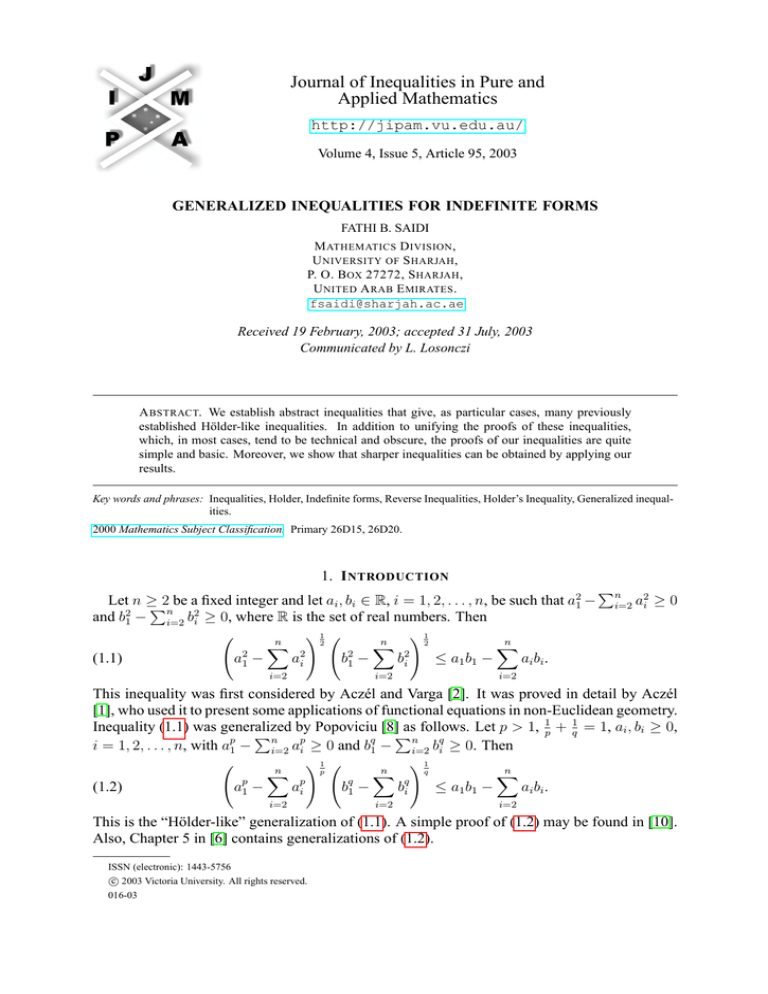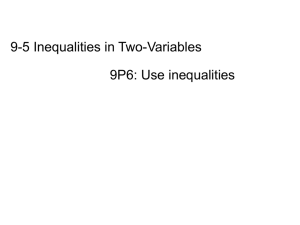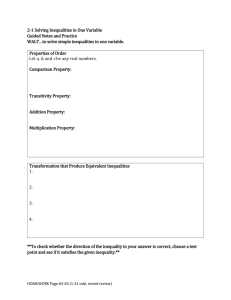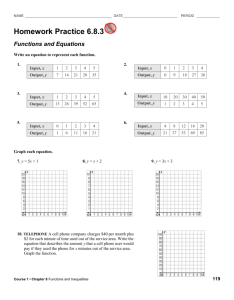
Journal of Inequalities in Pure and
Applied Mathematics
http://jipam.vu.edu.au/
Volume 4, Issue 5, Article 95, 2003
GENERALIZED INEQUALITIES FOR INDEFINITE FORMS
FATHI B. SAIDI
M ATHEMATICS D IVISION ,
U NIVERSITY OF S HARJAH ,
P. O. B OX 27272, S HARJAH ,
U NITED A RAB E MIRATES .
fsaidi@sharjah.ac.ae
Received 19 February, 2003; accepted 31 July, 2003
Communicated by L. Losonczi
A BSTRACT. We establish abstract inequalities that give, as particular cases, many previously
established Hölder-like inequalities. In addition to unifying the proofs of these inequalities,
which, in most cases, tend to be technical and obscure, the proofs of our inequalities are quite
simple and basic. Moreover, we show that sharper inequalities can be obtained by applying our
results.
Key words and phrases: Inequalities, Holder, Indefinite forms, Reverse Inequalities, Holder’s Inequality, Generalized inequalities.
2000 Mathematics Subject Classification. Primary 26D15, 26D20.
1. I NTRODUCTION
Let n ≥P2 be a fixed integer and let ai , bi ∈ R, i = 1, 2, . . . , n, be such that a21 −
and b21 − ni=2 b2i ≥ 0, where R is the set of real numbers. Then
! 12
! 12
n
n
n
X
X
X
2
2
2
2
b1 −
bi
≤ a1 b 1 −
ai b i .
(1.1)
a1 −
ai
i=2
i=2
Pn
i=2
a2i ≥ 0
i=2
This inequality was first considered by Aczél and Varga [2]. It was proved in detail by Aczél
[1], who used it to present some applications of functional equations in non-Euclidean geometry.
Inequality (1.1) was generalized by Popoviciu [8] as follows. Let p > 1, p1 + 1q = 1, ai , bi ≥ 0,
P
P
i = 1, 2, . . . , n, with ap1 − ni=2 api ≥ 0 and bq1 − ni=2 bqi ≥ 0. Then
! p1
! 1q
n
n
n
X
X
X
p
p
q
q
(1.2)
a1 −
ai
b1 −
bi
≤ a1 b 1 −
ai bi .
i=2
i=2
i=2
This is the “Hölder-like” generalization of (1.1). A simple proof of (1.2) may be found in [10].
Also, Chapter 5 in [6] contains generalizations of (1.2).
ISSN (electronic): 1443-5756
c 2003 Victoria University. All rights reserved.
016-03
2
FATHI B. S AIDI
For a fixed integer n ≥ 2 and p(6= 0) ∈ R, the authors in [5] introduced the following
definition:
! p1
n
X
, x ∈ Rp ,
(1.3)
Φp (x) := xp1 −
xpi
i=2
where
(
(1.4)
Rp =
x = (x1 , . . . , xn ) : xi ≥ (>) 0, xp1 ≥ (>)
n
X
)
xpi
if p > (<) 0.
i=2
There they presented inequalities for Φp from which they deduced, among other things, the
inequalities (1.1) and (1.2).
Finally, in [9] the authors introduced the following definitions, which generalize (1.3) and
(1.4). Let n be a positive integer, n ≥ 2, and let M be a one-to-one real-valued function whose
domain is a subset of R. Then, for α ∈ R,
xi
Rα,M = x = (x1 , x2 , . . . , xn ) : x1 > 0,
∈ Domain (M ) for i = 2, . . . , n,
x1
"
#
n
X
xi
and α −
∈ Range (M )
M
x1
i=2
and, for x ∈ Rα,M ,
"
Φα,M (x) = x1 M −1 α −
n
X
M
i=2
xi
x1
#
.
There the authors obtained generalizations of inequalities (1.1) and (1.2) and of the inequalities
in [5].
It is our aim in this paper to establish inequalities (see Theorems 2.1 and 2.2) that give, as
particular cases, all the inequalities mentioned above. In addition to unifying the proofs of these
inequalities, which, in most cases, tend to be technical and obscure in the sense that it is not
clear what really makes them work, the proofs of our inequalities are quite simple and basic.
Moreover, we show that sharper inequalities can be obtained by applying our results.
2. G ENERALIZED I NEQUALITIES
Let Rα,M and Φα,M be as defined above and let m ≥ 2 be an integer.
Theorem 2.1. Let M1 , M2 , . . . , Mm be one-to-one real-valued functions defined in R and let
M be a real-valued function defined on Domain (M1 ) × · · · × Domain (Mm ) and satisfying,
for all (t1 , . . . , tm ),
(2.1)
M (t1 , t2 , . . . , tm ) ≤ (≥)
m
X
σk Mk (tk ) ,
k=1
where σ1 , σ2 , . . . σm are fixed real numbers. Then
m
n
X
X
Φα1 ,M1 (x1 )
Φαm ,Mm (xm )
x1i
xmi
,...,
≤ (≥)
σk αk −
M
,...,
(2.2) M
x11
xm1
x11
xm1
i=2
k=1
for all αk ∈ R satisfying Rαk ,Mk 6= ∅ and all xk ∈ Rαk ,Mk , k = 1, . . . , m.
J. Inequal. Pure and Appl. Math., 4(5) Art. 95, 2003
http://jipam.vu.edu.au/
G ENERALIZED I NEQUALITIES FOR I NDEFINITE F ORMS
3
Proof. Using (2.1) and the definition of Φαk ,Mk (xk ), we obtain
m
X
Φαk ,Mk (xk )
Φαm ,Mm (xm )
Φα1 ,M1 (x1 )
,...,
≤ (≥)
σk Mk
M
x11
xm1
xk1
k=1
"
#
m
n
X
X
xki
σk αk −
Mk
=
xk1
i=2
k=1
m
n X
m
X
X
xki
σk αk −
σk Mk
=
xk1
i=2 k=1
k=1
m
n
X
X
x1i
xmi
≤ (≥)
σk αk −
M
,...
.
x
x
11
m1
i=2
k=1
This ends the proof.
Theorem 2.1, besides giving a unified and much simpler proof, is more general than many
previously established inequalities. Indeed, as is shown below in the remarks following Corollary 3.2, these inequalities can be obtained as consequences
of Theorem 2.1 with appropriate
Qm
choices for the Mk ’s and with M (t1 , . . . , tm ) := k=1 tk .
Moreover, since inequality (2.2) is sharper whenever M is larger (smaller), we can obtain
sharper inequalities each time we keep the same Mk ’s while modifying M so that the surface tm+1 = M (t1Q
, . . . tm ) in Rm+1 is distinct from and is P
between the two surfaces tm+1 =
m
m
P (t1 , . . . , tm ) := k=1 tk and tm+1 = S (t1 , . . . , tm ) :=
k=1 σk Mk (tk ). In other words,
each time we chose M 6= P, S such that, for every (t1 , . . . , tm ) ∈ Domain (M1 ) × · · · ×
Domain (Mm ),
(2.3)
m
Y
tk ≤ (≥) M (t1 , . . . tm ) ≤ (≥)
k=1
m
X
σk Mk (tk ) .
k=1
The closer M gets to S, the sharper the inequality is. Clearly, the optimum M is M (t1 , . . . , tm ) :=
P
m
k=1 σk Mk (tk ), in which case equality is attained in (2.2). But the idea is to choose an M that
satisfies (2.3) while being simple enough to yield a “nice inequality”. This, of course is most
useful when the Mk ’s are not that simple. Nevertheless, any choice of M satisfying (2.3) will
give a new inequality, strange as it may look.
To further clarify the above remarks, we establish the following consequence of Theorem
2.1, in which it is apparent that previous inequalities are particular cases and that Theorem 2.1
does indeed lead to sharper inequalities:
Theorem 2.2. Let M1 , M2 , . . . , Mm be one-to-one real-valued functions defined in R and satisfying, for all (t1 , . . . , tm ) ∈ Domain (M1 ) × · · · × Domain (Mm ),
(2.4)
m
Y
k=1
tk ≤ (≥)
m
X
σk Mk (tk ) ,
k=1
where σ1 , σ2 , . . . , σm are fixed real numbers. Let µ be any real-valued function defined on
Domain (M1 ) × · · · × Domain (Mm ) and satisfying, for every (t1 , . . . , tm ),
0 ≤ µ(t1 , . . . , tm ) ≤ 1.
J. Inequal. Pure and Appl. Math., 4(5) Art. 95, 2003
http://jipam.vu.edu.au/
4
FATHI B. S AIDI
Then
(2.5)
m
Y
m
X
Φαk ,Mk (xk ) ≤ (≥)
k=1
!
σk αk
k=1
−
n X
1−µ
i=2
m
Y
xk1 −
k=1
x1i
xmi
,...,
x11
xm1
n Y
m
X
i=2 k=1
m
X
!
xki
σk Mk
k=1
xki
xk1
m
Y
xki
−
xk1
k=1
!
m
Y
xk1
k=1
for all αk ∈ R satisfying Rαk ,Mk 6= ∅ and all xk ∈ Rαk ,Mk , k = 1, . . . , m.
Proof. For simplicity of notation, let
m
m
m
X
Y
Y
Φαk ,Mk (xk )
xki
α :=
σk αk , P (Φ) :=
, Pi (x) :=
,
xk1
xk1
k=1
k=1
k=1
m
m
X
X
Φαk ,Mk (xk )
xki
, Si (x) :=
σk Mk
,
S(Φ) :=
σk Mk
xk1
xk1
k=1
k=1
Φαk ,Mk (xk )
x1i
xmi
Φαk ,Mk (xk )
µ(Φ) := µ
,...,
, µi (x) := µ
,...,
.
xk1
xk1
x11
xm1
Let
!
m
m
m
Y
X
Y
M (t1 , . . . , tm ) :=
tk + (1 − µ (t1 , . . . , tm ))
σk Mk (tk ) −
tk .
k=1
k=1
k=1
Then M satisfies the inequalities in (2.3). Therefore we may apply Theorem 2.1 to obtain
P (Φ) + (1 − µ (Φ)) (S (Φ) − P (Φ))
n
X
(Pi (x) + (1 − µi (x)) (Si (x) − Pi (x))) .
≤ (≥) α −
i=2
Rearranging the terms, we get
P (Φ) ≤ (≥) α −
n
X
!
Pi (x)
−
i=2
n
X
!
(1 − µi (x)) (Si (x) − Pi (x))
i=2
− (1 − µ(Φ)) (S(Φ) − P (Φ)) .
Since the inequalities in (2.3) hold, we may drop the last term to obtain
!
!
n
n
X
X
P (Φ) ≤ (≥) α −
Pi (x) −
(1 − µi (x)) (Si (x) − Pi (x)) .
i=2
Multiplying both sides by
proof.
Qm
k=1
i=2
xk1 , which is positive, we obtain the result (2.5). This ends the
3. A PPLICATIONS
Let p1 , p2 , . . . , pm 6= 0 be real numbers satisfying p11 +
that
m
m
Y
X
1 pk
(3.1)
tk ≤
t ,
pk k
k=1
k=1
1
p2
+ ··· +
1
pm
= 1. It is well known
m
for every (t1 , . . . , tm ) ∈ Rm
+ := (0, ∞) , if and only if all pi ’s are positive. Inequality (3.1) is
known as Hölder’s inequality.
J. Inequal. Pure and Appl. Math., 4(5) Art. 95, 2003
http://jipam.vu.edu.au/
G ENERALIZED I NEQUALITIES FOR I NDEFINITE F ORMS
5
Also, one has the following reverse inequality to (3.1):
m
m
Y
X
1 pk
(3.2)
tk ≥
tk ,
p
k
k=1
k=1
for every (t1 , . . . , tm ) ∈ Rm
+ , if and only if all pi ’s are negative except for exactly one of them,
[9] and [11].
Setting Mk (t) := tpk , σk = p1k , and αk = 1, k = 1, . . . , m, in Theorem 2.2, we obtain
immediately the following corollary:
Corollary 3.1. Let p1 , p2 , . . . , pm 6= 0 be real numbers satisfying p11 + p12 + · · · + p1m = 1 and
let µ be any real-valued function defined on Rm
+ and satisfying, for every (t1 , . . . , tm ),
0 ≤ µ(t1 , . . . , tm ) ≤ 1.
(3.3)
If all pi ’s are positive (all pi ’s are negative except for exactly one of them), then
! p1
!
m
n
m
n Y
m
k
Y
X
Y
X
pk
pk
(3.4)
xk1 −
xki
≤ (≥)
xk1 −
xki
i=2
k=1
−
i=2 k=1
k=1
n X
1−µ
i=2
! m
X
p
m
m
x1i
xmi
1 xki k Y xki Y
,...,
−
xk1
x11
xm1
pk xk1
xk1 k=1
k=1
k=1
for all xk ∈ R1,tpk , k = 1, . . . , m.
Dropping the last term in (3.4), we obtain Corollary 1 of [5]:
Corollary 3.2. Let p1 , p2 , . . . , pm 6= 0 be real numbers satisfying p11 +
inequality
m
m
n Y
m
Y
X
Y
(3.5)
Φpk (xk ) ≤ (≥)
xk1 −
xki
k=1
k=1
1
p2
+ ··· +
1
pm
= 1. The
i=2 k=1
holds for all xk ∈ Rpk , k = 1, . . . , m, if and only if all pk ’s are positive (all pk ’s are negative
except for exactly one of them).
Note that inequality (3.4) is sharper than inequality (3.5). Choosing µ ≡ 1, (3.4) gives (3.5).
But any other choice of µ, satisfying (3.3), will give a sharper inequality. Of course, one may
choose µ ≡ 0 to obtain the sharpest inequality from (3.4). But, by keeping µ in (3.4), we give
ourselves the freedom of choosing µ in such a way as to make the last term in (3.4) as simple
as possible. This is a trade we have to make between the sharpness of inequality (3.4) and its
simplicity.
Finally, we note that inequalities (1.1) and (1.2) are particular cases of inequality (3.5) and,
consequently, of inequality (3.4).
We conclude by noting that from Páles’s paper [7] and from Losonczi’s papers [3] and [4] it
follows that inequalities (3.1) and (3.2), written in the form
m
m
Y
X
tpkk − 1
, (t1 , t2 , . . . , tm ) ∈ Rm ,
tk − 1 ≤ (≥)
pk
k=1
k=1
are equivalent to
(3.6)
Mn,1
m
Y
k=1
!
xk
≤ (≥)
m
Y
Mn,pk (xk ), n ∈ N, xk ∈ Rn+ , k = 1, 2, . . . , m,
k=1
J. Inequal. Pure and Appl. Math., 4(5) Art. 95, 2003
http://jipam.vu.edu.au/
6
FATHI B. S AIDI
where xk := (xk1 , xk2 , . . . , xkn ), k = 1, 2, . . . , m, and
Pn xpj p1
if p 6= 0,
j=1 n
Mn,p (x) := Mn,p (x1 , x2 , . . . , xn ) :=
√
n
x1 x2 · · · xn if p = 0.
Inequality (3.6) was completely settled by Páles, [7, corollary on p. 464].
R EFERENCES
[1] J. ACZÉL, Some general methods in the theory of functional equations in one variable, New applications of functional equations, Uspehi. Mat. Nauk (N.S.) (Russian), 69 (1956), 3–68.
[2] J. ACZÉL AND O. VARGA, Bemerkung zur Cayley-Kleinschen Massbestimmung, Publ. Mat. (Debrecen), 4 (1955), 3-15.
[3] L. LOSONCZI, Subadditive Mittelwerte, Arch. Math., 22 (1971), 168–174.
[4] L. LOSONCZI, Inequalities for integral means, J. Math. Anal. Appl., 61 (1977), 586–606.
[5] L. LOSONCZI AND Z. PÁLES, Inequalities for indefinite norms, J. Math. Anal. Appl., 205 (1997),
148–156.
[6] D.S. MITRINOVIĆ, J.E. PEČARIĆ AND A.M. FINK, Classical and New Inequalities in Analysis,
Kluwer Academic Publishers, Dordrecht, 1993.
[7] Z. PÁLES, On Hölder-type inequalities, J. Math. Anal. Appl., 95 (1983), 457–466.
[8] T. POPOVICIU, On an inequality, Gaz. Mat. Fiz. A, 64 (1959), 451–461 (in Romanian).
[9] F. SAIDI AND R. YOUNIS, Generalized Hölder-like inequalities, Rocky Mountain J. Math., 29
(1999), 1491–1503.
[10] P.M. VASIĆ AND J.E. PEČARIĆ, On the Hölder and related inequalities, Mathematica (Cluj), 25
(1982), 95–103.
[11] XIE-HUA SUN, On generalized Hölder inequalities, Soochow J. Math., 23 (1997), 241–252.
J. Inequal. Pure and Appl. Math., 4(5) Art. 95, 2003
http://jipam.vu.edu.au/





